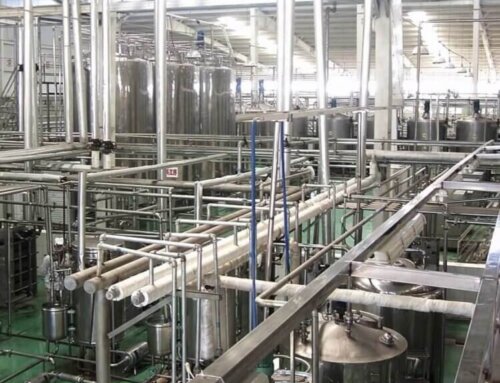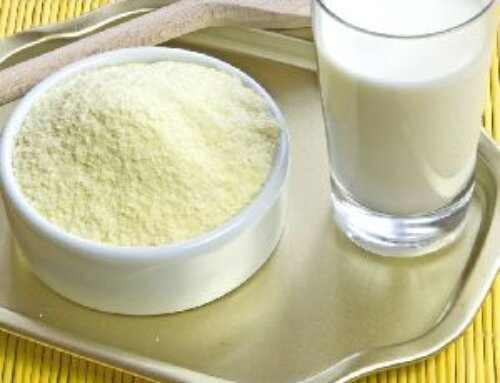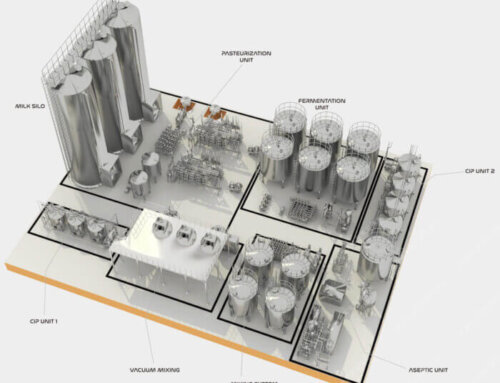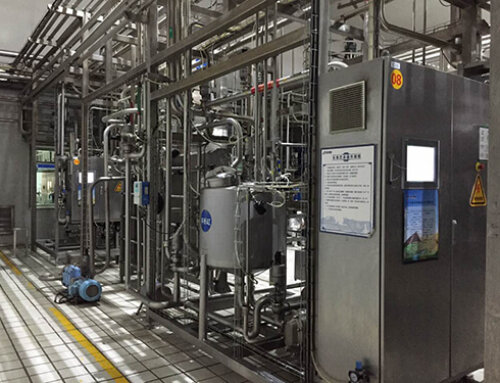Project Description
Pasteurized Milk Processing Line
Description Of Pasteurized Milk Processing Line
- Milk is a liquid squeezed from the udder of a cow. It contains calcium, phosphorus, sodium, magnesium, vitamins, carbohydrates and other substances needed by humans. Milk is hailed as “the most perfect food given to mankind by God”.
- The raw milk is pasteurized. After pasteurization, the protein and most of the vitamins in the raw milk are basically intact, but it does not kill all microorganisms 100%. Pasteurized milk has strict requirements on the storage environment and needs to be stored in low temperature (3-5℃)storage. The shelf life is 2-7 days.
- The pasteurized milk uses fresh cow or goat milk as raw material, then centrifuge purified, standardized, homogenized, pasteurized, cooled and at last filled into bottles, plastic pouches or gable top cartons. It is directly supplied to consumers as commercial milk for drinking.
- Through heat treatment, the harm of pathogenic microorganisms in the pasteurized milk is minimized as much as possible, and the chemical, physical and sensory changes in the product are minimized.
- The pasteurized milk heat treatment is at 85-95℃ for a few seconds, which can ensure that the nutrient loss and flavor of milk are preserved to the maximum under the premise of killing all pathogenic bacteria in the milk.
- Whole pasteurized milk, reduced-fat milk, low-fat pasteurized milk and skimmed pasteurized milk can be produced according to clients’ different requirements.
- The production conditions of pasteurized milk are very harsh. Not only high-quality and safe milk sources, mechanized enclosed milking, but also low-temperature refrigeration throughout the process, all make the price of pasteurized milk relatively high. In the past, only the royal family could afford it. Fortunately, modern technology is developed. The price of fresh milk has gradually become civilianized, and the general public can also enjoy the freshness of pasteurized milk.
- The whole pasteurized milk processing line is equipped with CIP cleaning system, and all the milk contact parts are SUS304 or SUS316L, which can guarantee the hygiene requirements.
- The pasteurized milk production process typically involves several stages, including raw milk reception, standardization, clarification, pasteurization at 72-75°C for 15 seconds, cooling, filling, and packaging.
- The capacity for the whole pasteurized milk processing line is from 500LPH to 50000LPH available to choose from.
Pasteurized Milk Physicochemical Index
| Item | Whole Pasteurized Milk | Partially Skimmed Pasteurized Milk | Skimmed Pasteurized Milk | ||
|---|---|---|---|---|---|
| Fat Content | ≥3.1% | 1.0%-2.0% | ≤0.5 | ||
| Protein Content | ≥2.9 | ||||
| Non-fat Milk Solids | ≥8.1% | ||||
| Acidity Value | ≤18.0°T | ||||
| Impurity | ≤2mg/kg | ||||
| Total Number Of Colonies | ≤30,000cfu/ml | ||||
| Escherichia Coli | ≤90MPN/100ml | ||||
| Pathogenic Bacteria | NA | ||||
End Product&Package Of Pasteurized Milk Processing Line
Whole Pasteurized Milk: packed in 100g-1000g small pouches, 200ml-3000ml bottles or 100ml-1000ml small gable top cartons transported and stored in 2-6℃with a shelf life of 5-7 days.
Skimmed Pasteurized Milk: Filled in 100g-1000g small pouches, 200ml-3000ml bottles or 100ml-1000ml small gable top cartons transported and stored in 2-6℃with a shelf life of 5-7 days.

Type Of Pasteurized Milk
Pasteurized milk: It uses raw milk as raw material and requires high milk sources and is processed by pasteurization. The purpose is to kill all pathogenic microorganisms in the milk, the production process is to heat at 75-85 ℃ holding for 10-15 seconds, then cold filling into containers. The shelf life is generally not more than 7 days keep refrigerated at 2-6 degrees. Because it is low-temperature sterilization, on the basis of killing microorganisms, it can retain the natural and original nutrients of milk to the greatest extent.
ESL milk: The full name is extended shelf life pasteurized milk, which is also called ultra-pasteurized milk. It is produced on the basis of improving the sterilization process and improving the sanitation level of the filling equipment. It mainly adopts the ultra-pasteurization method, 125-130℃holding for 2.5-4 seconds, then use ultra-clean filling technology to fill milk into bottles or carton box. The shelf life is 10 -30 days keep refrigerated at 2-6 degrees. In the process of producing ESL milk, we should try our best to avoid re-contamination of the product during processing, packaging and distribution, which requires high sanitary conditions and an excellent cold chain distribution system. Generally, the lower the cold chain temperature, the longer the product shelf life. It is between ordinary pasteurized milk and UHT milk, and it is still pasteurized milk in essence.
Technological Flowchart Of Pasteurized Milk Processing Line
The whole pasteurized milk processing line includes milk receiving system, milk weighing system, milk cooling system, milk storage system, milk filter and clarification system, milk pasteurization system and pasteurized milk filling system. Firstly, the raw milk will be tested with sensory, physical, chemical, and microbiological in the milk farm. After passing the test, the milk is transported to the milk processing center through the milk truck, and then the truck milk is transported to the milk weighing tank through the milk pump for measurement. After that, the double filter is applied to remove the impurities in the milk, and then cools the milk to 4°C through a milk cooling tank or a plate heat exchanger and stores them in the insulation tank. Then use centrifuge separating treatment to remove fat content according to customer requirements, and finally after homogenization, degassing and pasteurization, the pasteurized milk is filled into the container for drinking.

Key Machine Of Pasteurized Milk Processing Line
Milk weighing and receiving tank
The milk weighing tank and receiving tank usually will be used in match. The milk weighing tank is usually matched with milk collection equipment which can improve milk collection efficiency. This equipment is featured as good looking, simple structure, easy to clean; this equipment adopts active screen in order to stop impurity in the milk.

Milk purification system
In milk purification system, two machines are mostly used: a disk centrifuge separator and a microfiltration system.
—The two-stage disk centrifuge separator can be used for removing impurities such as dust, somatic cells, udder tissue, and other solid particles from raw milk. At the same time, it can also be used for separating spores and bacteria, especially heat-resistant ones like Bacillus and Clostridium. It will enhance milk safety and shelf life before pasteurization after the milk separator.
—The microfiltration system is used as a pre-treatment before pasteurization to effectively remove 90–99% of bacteria and spores in milk, followed by low-temperature pasteurization to extend shelf life and retain nutrients. When milk passes through the microfiltration membrane, bacteria, yeast, and spores(0.5-5 μm) that are larger than the membrane pore size(0.1-0.2 μm) are effectively retained, while small molecules such as water, lactose, and minerals in the milk can pass through the membrane smoothly.
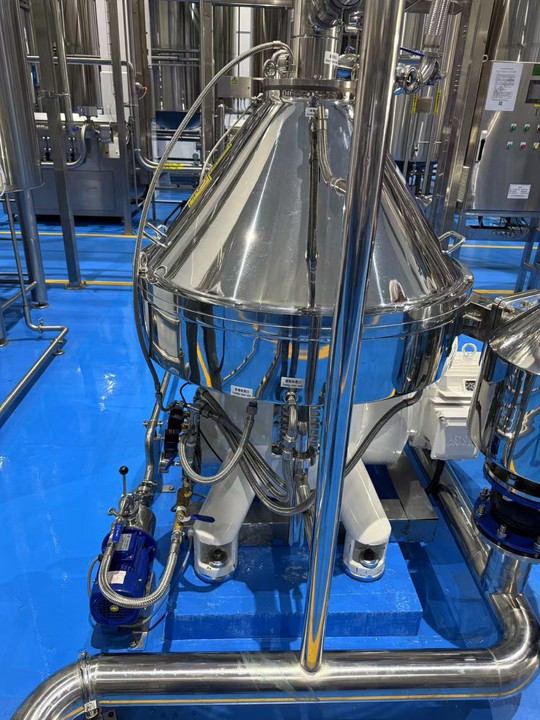
Milk cooling system
The milk cooling system has two type: if your raw milk is in a low capacity, then the milk cooling tank will be used, if the raw milk capacity is high, then, we will use the plate type heat exchanger(PHE) to cool down milk to 4℃, and the plate type cooler has high efficiency and can work continuously. The milk cooling tank has an integrated function with cooling and storage, but it has low efficiency and cooling time is long, whereas the PHE+chill water system is capable of continuous cooling and big capacity.

Milk storage tank
If you use the PHE to cool the milk, after the milk is cooled to 4°C, we need to use the milk pump to transfer the milk to the full closed SUS304 insulation tank to guarantee the milk will not be spoiled. The milk will be stored into the double layers insulation tank for the next processing. The milk insulation tank is equipped with the temperature sensor, material inlet and outlet, CIP cleaning ball, level flowmeters, manhole and so on.

Milk Pasteurizing system
The milk pasteurizing system is composed of plate pasteurizer, homogenizer, degasser and centrifuge separator unit. It is also the core unit of the whole pasteurized milk processing line. The homogenizer can decrease milk fat globule into small fat particles to maintain the stability of the emulsion with 20-25mpa high pressure, and the degasser can remove the air in the milk to extend the shelf life of the milk. The pasteurizer is mainly removing the Pathogenic bacteria in milk and the centrifuge separator can remove the fat content in the milk to make into skimmed pasteurized milk and make milk standardized.
The milk pasteurization process is raw milk 4°C inlet, then use hot water or steam to preheat to 55°C, at this temperature, the milk can be separated fat into skimmed milk, then remove the air in the degasser, and then go to high-pressure homogenizer, after this process finished, the milk will be heated to 72-85°C and holding for 10-15 seconds, then cooled to 4 °C outlet for filling. This process can kill the pathogenic bacteria in cow milk that can cause the outbreak of human food-borne diseases, such as E. coli, Bacillus, Listeria, etc., and it can also reduce the number of microorganisms that cause milk spoilage. The pasteurization process almost no damage to whey protein, immunoglobulin, vitamins, enzymes and other active substances. After pasteurization, the fresh milk can not only be stored for 5-7 days in a refrigerated environment at 2~6℃, but also retain a large number of active nutrients, especially the natural and mellow taste of milk.
The milk pasteurizer can be made into three sections (milk heating, milk cooling and heat recovery) or four sections ( milk heating, milk homogenizing, milk cooling and heat recovery), The more sections, the higher the heat recovery efficiency, basically the milk plate pasteurizer heat recovery rate is more than 90%.

Pasteurized milk filling system
The pasteurizing milk is filled into bottles, pouches or gable top cartons. The filling temperature is room temperature filling or cold filling to keep the nutrient of the milk. And the shelf life of the end pasteurized milk is 7-14 days according to the packaging container and pasteurizing temperature. After filling, the pasteurized milk needs to transport and store in chilled environments(4℃) to obtain the stable quality of the end products.

CIP cleaning system
The CIP cleaning system is also very important equipment for pasteurized milk processing. The main function is that the CIP system can clean protein and nutrients of in the pipelines, equipment and tanks to make sure the whole processing line stays clean and hygienic. The cleaning procedure can be carried out during production or after production finished according to different type of CIP system.

